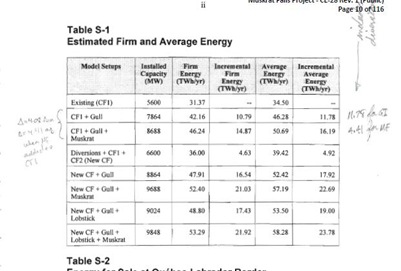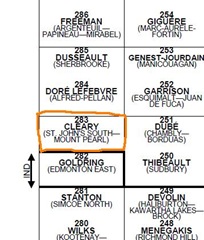Apparently, this whole Hebron work thing is much ado about nothing.
Premier Kathy Dunderdale spent some time Monday afternoon chatting with
On the Go’s Ted Blades about a recent decision by Kiewit to take a pass bidding on a second topsides module for the Hebron project.
Labour was tight. The company was having trouble delivering on time and on budget.
At one point, the Premier said there would be more work. The size of the topsides has apparently gone from the original estimate of 11,000 tons to 18,000 tons.
So, sez the Premier, there’ll be 18,000 tons of work.
You know, that’s something that always puzzled humble e-scribblers. When people say there’s tons of work, now you know what they mean. Don’t look for the number of people on the job. Forget the number of hours of labour.
Work now is measured in tons.
You cannot make this stuff up.
You wouldn’t.
You’d be afraid to make something like that up because people would never believe that the Premier of the province could say such a thing.
But she did.
Dunderdale also tried to claim that the crowd what has been running the place since 2003 were the first ones to copper-fasten the amount of work to be done locally on an offshore project. Others, she said, had settled for “best efforts.”
Kathy didn’t say copper-fasten but that’s one of her favourite little bits of meaningless jargon. Like referring to something as a piece. Like the Hebron piece. Or the Kiewit piece.
But anyway, first time for nailing stuff down right to the gram or work that had to be done in the province.
All that would be wonderful, of course.
Splendiferous even, except that it isn’t true.
Construction of the gravity base for the project was always going to be done in Newfoundland. That’s the cheapest way to do things. The provincial government didn’t get anything there they didn’t already have going into the meeting.
And then there is a bunch of small time stuff like a tube called the flare boom. Low tech metal bashing, for sure, and again, nothing of any difficulty to get done in someone’s back yard welding shop.
But the topsides modules, utilities and process module and other big stuff covered in Sections 5.5 B, C,and D of the
benefits agreement, well those are all subject to conditions. The conditions are secret. They are considered to be commercially sensitive.
They are
not copper-fastened at all.
As for the rest of the project, the Hebron final agreement has more than a few give-aways in it.
The companies got a
huge break on financing research and development. Kathy and her former boss let the companies skate with a pittance of a cash commitment compared to what the offshore regulatory board rules required.
On royalties, Kathy and her old boss gave the companies a break up front as well. Instead of an escalating percentage of revenue, Kathy and Danny gifted the companies with a flat one percent for as long as it takes to pay off the project development costs.
When Roger Grimes talked about such an idea, back when oil prices were forecast to stay low forever, Danny tore great strips off Grimes’ hide. As it turned out Danny gave the oil companies a gigantic break when prices were high. And Kathy Dunderdale totted out in front of the cameras to tell news media it was a way of giving the oil companies some protection against changes in oil prices.
Just think about that, in hindsight.
Back then - in 2008 - Kathy was running to protect oil companies against the chance oil prices might drop.
The poor old multinational multi-trillionaire oil companies.
Too fragile to take the risk.
A couple of years later – in 2010 – oil prices were going to be high forever. That is the justification for Muskrat Falls. And what about protecting taxpayers from the possibility oil prices might fall? Out trots Kathy and then Shawn and now Jerome to say there’s no chance of that happening.
And so the taxpayers of Newfoundland and Labrador, the people who own the oil and gas and the water, having given the oil companies a break must now dig ever deeper into their own pockets to ensure their electricity prices are high. Nova Scotians, meanwhile, will get their power for free, except for three months of the year when Muskrat apparently can’t deliver the juice.
Not much of a local benefit in that. Sure, Tory supporters will tell you all about what Danny got in exchange. Like equity stakes.
Hang on a second.
Equity.
No small irony that the two big issues in the province are the Lower Churchill on the one hand and Hebron on the other. Those
equity stakes, including the one in Hebron, were always about one thing:
financing the Lower Churchill. Local benefits were entirely secondary.
Don’t believe it?
Williams broke off Hebron talks in 2006 because he couldn’t get an equity stake. Nothing else. After 18 months of public pissing matches and private suck jobs, Williams got a deal on Hebron.
But he didn’t pick up any local benefits that weren’t already on the table in 2006. The so-called super-
royalty won’t add much beyond what the province would have received under the same royalty regime that is delivering in spades on projects like Hibernia and Terra Nova and White Rose.
Equity was the thing.
The first thing.
The most important thing.
So important that
Danny even told Arnold about it:
The Premier also discussed the province's Energy Plan objective of using non-renewable resource revenues to fuel a future based on renewable sources of energy.
At times like this, it is always interesting to go back and see what was running around at the time. This time look at
August 2007 and the rather convenient election announcement of a Hebron deal:
6. Shortage of workers means shortage of work.
In the last round of negotiations, the provincial government insisted that any work that could be done in Newfoundland and Labrador had to be done there or the companies would pay a penalty. Reportedly, the companies noted that Long Harbour plus the Lower Churchill would outstrip the local labour and engineering pool making it almost impossible to complete Hebron using only local resources.
Cancellation of Hebron last year meant that workers who would have started work on Hebron have already headed west to the higher wages of Alberta. That made the predicted situation worse, not better and therefore will make it harder for the province to stick with that bargaining point.
Expect that provincial demand to drop off the table or for Hebron to get preference over the Lower Churchill. Otherwise, the cost of the project will be forced up.
Your humble e-scribbler had plenty of people from the local oil and gas community point that out. The companies talked about labour force shortages and costs, they said. The final Hebron agreement reflected the limited capacity in the local market to do some of the bigger components for Hebron. The only things the companies had to do here was what they absolutely had no choice but do here.
Not surprisingly, that old demand for guaranteed local benefits or suffer a penalty disappeared.
And equally unsurprisingly, the provincial government’s news release talked up the GBS and the small stuff – “
outstanding local benefits” – but only after they played up the equity.
Makes you wonder why Kathy Dunderdale is talking about Kiewit and Marystown like it was some kind of surprise to her. She’s known about the whole thing from the beginning: Hebron, the Lower Churchill, jobs, local benefits and the equity.
The equity.
It’s always been about the equity. That’s what ties it all together.
- srbp -





